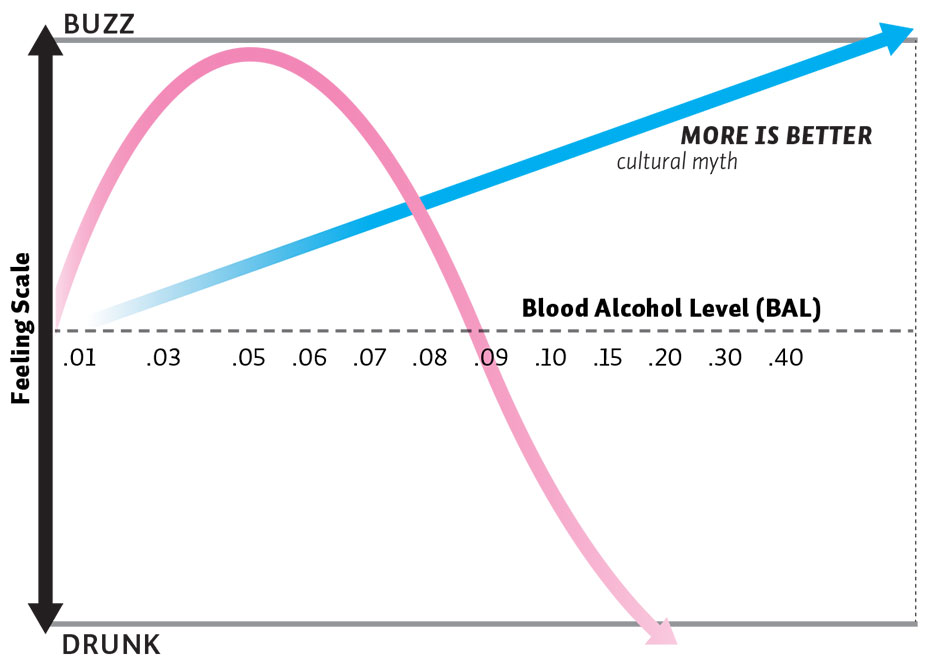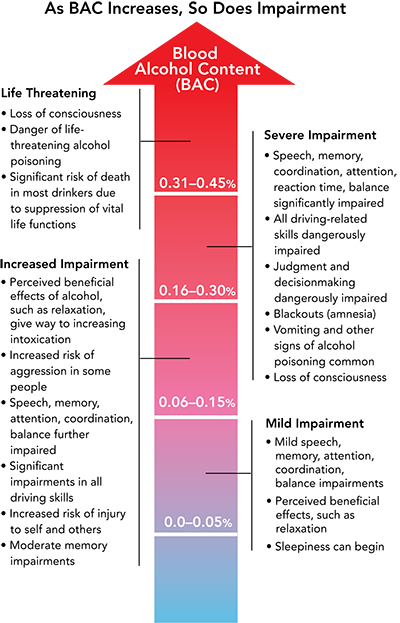
Recognize Alcohol Poisoning
Recognizing the Signs of Alcohol Poisoning
Alcohol poisoning occurs when there is so much alcohol in the body that the organs begin to shut down. Alcohol is a depressant, and the depressant effects increase as more alcohol is consumed to point where the brain can no longer support life sustaining functions like breathing or the gag reflex. BAC can continue to rise when a person is unconscious, so it can be very dangerous to leave a person alone to “sleep it off.”
Puking while passed out: People may vomit after drinking too much, as a way for the body to rid itself of alcohol BEFORE reaching dangerous blood alcohol levels. But, if a person is vomiting AND they are passed out or are struggling to stay awake at the time they are vomiting, this is a clear sign of alcohol poisoning.
Unresponsive to simulation (pinching or shaking): a person who cannot be awakened may be in serious danger. Call for help immediately!
Breathing is shallow and slow: typically, a person whose breathing is very shallow and slow will also be difficult to rouse or wake up. This is a sign that the person’s respiratory system is depressed and they may not be getting enough oxygen to the brain and are in danger of choking on their vomit.
Skin is cold, clammy, or blue: blue skin indicates a severe lack of oxygen and must be addressed immediately to save the person’s life. If a person’s skin is not blue, the person may still need medical attention. If they have cold and clammy skin combined with any other symptom (like unresponsiveness or slow breathing), call for help immediately.
Here are some other critical signs and symptoms to watch out for:
- Mental confusion, stupor, coma, or inability to wake up
- Vomiting
- Seizures
- Slow breathing (fewer than 8 breaths per minute or more than 10 seconds between breaths)
- Irregular breathing (10 seconds or more between breaths)
- Hypothermia (low body temperature), bluish skin color, paleness
Coffee, cold showers, or sleeping it off WILL NOT reverse an alcohol overdose. You should call 911 immediately! Remember, Wisconsin has a Good Samaritan Law which protects the overdose victim and the caller from being charged with underage drinking. UW Oshkosh also has a medical amnesty policy, which protects students in emergency situations.
Visit the Mayo Clinic for more information about alcohol poisoning.
UW Oshkosh Alcohol Policy
UW Oshkosh Alcohol Policy
- The alcohol policy of the University and the residence halls is in place to enforce state law and to ensure a safe and secure environment for all residents. Keep in mind that even after you attain the legal age to consume alcohol, it is still an expectation that you consume alcohol responsibly and not engage in behavior that will negatively impact others.
- If an underage student is found in possession of alcohol, University Officials possess the right to dispose of, or have the student dispose of, all alcohol present in the area, including empty alcohol containers.
- If an underage student is found in possession of alcohol paraphernalia (e.g. beer bong, beer bottles full of sand or highlighter fluid, etc.), University Officials possess the right to confiscate all illegal items of this nature present in the area.
Medical Amnesty: What's it all about?
Have you ever seen someone passed out drunk and thought about calling 911, but didn’t? What stopped you?
Research suggests that fear of police involvement may be the main reason why people do not seek help in an overdose situation. In 2015, Wisconsin passed the Wisconsin Act 279, which provides amnesty for people seeking help in the event of an overdose of drugs or alcohol. For more information about Medical Amnesty at UWO, refer to the University Police website.
What is BAC?
BAC means Blood Alcohol Content, and it is a measurement of the amount of alcohol in your bloodstream at a given time. Many of you may have heard BAC in reference to DUI laws, which prohibit driving with a BAC of 0.08 or higher. BAC is also a useful tool to gauge your level of intoxication.
When your BAC is low and rising, you tend to feel happy, excited, and confident. As your BAC gets higher, the depressant effects of alcohol kick in. At first, you start to feel uncoordinated, and maybe a little tired. At that point, people will often try to have another drink to get the good feelings back, but as your BAC gets higher and higher, you don’t get any more social benefits without also getting sloppy. This is called the bi-phasic response to alcohol.
What factors influence BAC?
1. Sex: Males and females have biological differences that allow males to more efficiently process alcohol. This means a male and a female of the same body weight could drink exactly the same amount of alcohol in the same amount of time and the male will have a lower BAC.
2. Body weight: The more you weigh, the lower your BAC.
3. Number of drinks: This one is a no-brainer right? The more you drink, the higher your BAC.
4. The amount of time you are drinking: 5 shots in 1 hour will lead to a much higher BAC than 5 drinks over 5 hours.
How much is 1 drink?
Even though they come in different sizes, the drinks above are each examples of one standard drink. In the United States, one “standard” drink contains around 14 grams of pure alcohol.
Are you in the “buzz zone”?
We call 0.06 and below the “buzz zone” because you get the maximum social benefits with the least amount of impairment, which is why we like to call this the “buzz zone.”
What’s your drinking pattern?
Additional Resources:
Alcohol-Based Calculators: http://rethinkingdrinking.niaaa.nih.gov/tools/Calculators/Default.aspx
Alcohol & Your Health from NIAAA: https://niaaa.nih.gov/alcohol-health
Centers for Disease Control: http://www.cdc.gov/alcohol/index.htm





